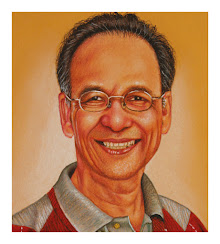Here's an excerpt, pertaining to Perspectives On Entrepreneurship, from Dilip Mukerjea's book, Brainaissance: The Renaissance of the Brain, The Rebirth of Imagination:
Peter F. Drucker on Innovation and Entrepreneurship
Drucker maintained that entrepreneurship is doing something differently so as to better use resources and expand markets for the product and/or service. From a hamburger stand in a single city, Ray Kroc turned it into an international business, McDonalds; this happened by innovating his products, services, and marketing. Kroc was an entrepreneur. Someone else running that hamburger stand without Kroc’s entrepreneur spirit may have had a thriving hamburger business but it wouldn’t have been McDonalds and that person wouldn’t have been an entrepreneur, just another hamburger stand owner. Drucker also believed that entrepreneurship and innovation are not inborn characteristics. They are behaviors that most people can learn and successfully apply to their ventures.
He described seven sources of innovative opportunity:
The Unexpected - via unexpected success, unexpected failure, and unexpected outside events.
Incongruities - a discrepancy or dissonance between what is and what ought to be or is assumed to be, comprising four areas: economic realities of an industry (marketplace), other realities of an industry (optimisation of local, non-essential areas rather than system optimisation), customer expectations versus the industry perception of customer expectations, and internal incongruity with a process.
Process Need - a weak or missing link in a process that makes the process cheaper, easier, or possible, through technological or economical feasibility.
Industry and Market Structures - changes in industry or markets such as new competitors, new customers, more differentiated products, new manufacturing or marketing processes, new substitute or complementary products or services.
Demographics - changes in population structure such as size, age, cultural composition, employment, education, and income.
Changes in Perception - a change in the way facts are perceived, such as determining whether “the glass is half full” versus “the glass is half empty.”
New Knowledge - the discovery of new knowledge, which can be exploited, such as a new technology or new materials.
He debunked the belief that innovation is “a bright idea” and maintained that dependable innovative ideas come from systematic exploration of the seven sources of innovative opportunity. Drucker called The Bright Idea “the riskiest and least successful source of innovation opportunities.” The millions of worldwide patents that sit in patent offices gathering dust lend credence to his assertion.
Entrepreneurs innovate. Innovation is the specific instrument of entrepreneurship. It is the act that endows resources with a new capacity to create wealth. Innovation, indeed, creates a resource. There is no such thing as a resource until man finds a use for something in nature and then endows it with economic value. Until then, every plant is a weed and every mineral just another rock.
~ Peter F. Drucker, The Sage of Business Wisdom




















No comments:
Post a Comment